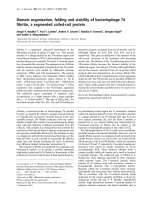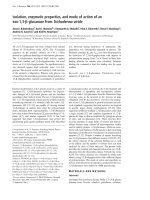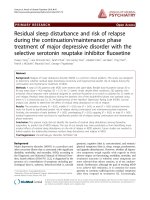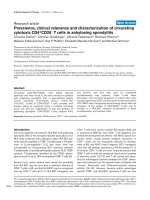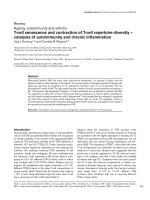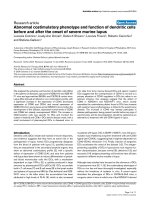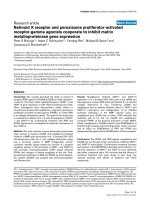Báo cáo y học: "Continuity, psychosocial correlates, and outcome of problematic substance use from adolescence to young adulthood in a community sample" pptx
Bạn đang xem bản rút gọn của tài liệu. Xem và tải ngay bản đầy đủ của tài liệu tại đây (263.08 KB, 9 trang )
BioMed Central
Page 1 of 9
(page number not for citation purposes)
Child and Adolescent Psychiatry and
Mental Health
Open Access
Research
Continuity, psychosocial correlates, and outcome of problematic
substance use from adolescence to young adulthood in a
community sample
Hans-Christoph Steinhausen*, Susanne Eschmann and
Christa Winkler Metzke
Address: Department of Child and Adolescent Psychiatry, University of Zurich, Neumuensterallee 9, CH 8032 Zurich, Switzerland
Email: Hans-Christoph Steinhausen* - ; Susanne Eschmann - ;
Christa Winkler Metzke -
* Corresponding author
Abstract
Background: The study of the continuity, psychosocial correlates, and prediction of problematic
substance use (PSU) across time from adolescence to young adulthood.
Methods: Substance use was studied in a cohort of N = 593 subjects who had been assessed at
three times between adolescence and young adulthood within the Zurich Psychology and
Psychopathology Study (ZAPPS). Based on the frequency of tobacco, alcohol, and cannabis
consumption, groups with PSU were defined at each of the three measurement points in time and
compared to the rest of the sample. Comparisons included questionnaire data regarding emotional
and behavioural problems, life events, coping style, self-related cognitions, perceived parenting
style, perceived school environment, and size and efficiency of the social network.
Results: The size of the groups with PSU increased continuously across time. The cross-sectional
correlates of PSU were characterized by a similar pattern that included higher scores for
externalizing behaviour, and both number and negative impact of life events across all three times.
At time 1 and 2 subjects with PSU also experienced less favourable parenting styles and school
environments. Longitudinally, PSU in young adulthood was predicted most strongly and persistently
by previous risk status, externalizing problems and male gender.
Conclusion: Problematic substance use is a major problem in youth. Its contributing pattern of
associated and predictive psychosocial variables can be identified in the community.
Introduction
In a recent review of drug abuse research it has been stated
that some of the advancements parallel concepts that are
also part of the developmental psychopathology
approach. Among various research areas, this perspective
includes antecedent and co-occurring psychopathological
conditions and other problem behaviour [1]. To date,
there is only a small number of longitudinal studies that
have taken this perspective by studying the association of
adolescent substance use with adult outcome [e.g. [2-5]]
Published: 11 October 2007
Child and Adolescent Psychiatry and Mental Health 2007, 1:12 doi:10.1186/1753-2000-1-
12
Received: 21 May 2007
Accepted: 11 October 2007
This article is available from: />© 2007 Steinhausen et al; licensee BioMed Central Ltd.
This is an Open Access article distributed under the terms of the Creative Commons Attribution License ( />),
which permits unrestricted use, distribution, and reproduction in any medium, provided the original work is properly cited.
Child and Adolescent Psychiatry and Mental Health 2007, 1:12 />Page 2 of 9
(page number not for citation purposes)
or the developmental antecedents, patterns, and corre-
lates of substance use in adolescence [6-10].
Within the developmental perspective of adolescent sub-
stance use, various risk factors including life stress, per-
sonality features, parental behaviour, peer influences,
school characteristics, and other environmental features
have been studied as can be delineated from both major
reviews and empirical studies [6,11-17]. The frequent co-
occurring mental disorders and behaviour problems have
been addressed particularly in another series of recent
reviews with a strong emphasis on co-morbid conduct dis-
orders or externalizing problems [13,18-20].
The present study attempted to shed some more light on
the developmental trajectories of substance use from ado-
lescence to young adulthood. Based on data from a longi-
tudinal study, the main focus was on problematic
substance use rather than on substance use disorders. In
accordance with various studies, weekly or daily con-
sumption of tobacco and/or alcohol, problem and heavy
drinking aiming at drunkenness, and cannabis use more
frequently than three times in the past month was consid-
ered to reflect problematic substance use [21]. The major
aim of the present study was the analysis and predictive
power of selected psychosocial correlates across time in
subjects with problematic substance use (PSU). The psy-
chosocial correlates of the longitudinal study had been
selected on the basis of a theoretical model that will be
outlined with the methods below.
Three main questions were addressed in the analyses.
First, the continuity of PSU across time was studied. The
second series of cross-sectional analyses compared psy-
chosocial correlates in the PSU groups at each time with
the rest of the sample representing the controls. The third
question asked for preceding psychosocial markers during
middle and late adolescence of later PSU in young adult-
hood and was, thus, using the longitudinal data.
Method
Subjects
Originally, the present sample is based on a cohort of N =
1,964 pupils aged 6 to 17 who were living in the Canton
of Zurich, Switzerland in 1994. The cohort was a stratified
randomized sample representing the 12 counties of the
canton, the school grades, and the types of school and
formed the basis of the Zurich Epidemiological Study of
Child and Adolescent Psychopathology (ZESCAP). A full
description of details of the sampling procedure was given
in a previous article [22]. The preadolescents and adoles-
cents (aged 11 – 17 years) of the ZESCAP sample (N =
1110) provided the basic cohort of the longitudinal
Zurich Adolescent Psychology and Psychopathology
Study (ZAPPS).
This cohort of 1110 subjects was studied longitudinally at
three times, namely, in 1994 (time 1), 1997 (time 2) and
2001 (time 3). At each time, a multidimensional screen-
ing based on various questionnaires was performed. Sub-
sequently, structured psychiatric interviews were used
with those subjects who scored above the cut-off scores
and with a certain number of controls scoring below the
cut-off score on each screening instrument. Due to the
screening procedure the sample was reduced at each time.
In addition, subjects dropped out from the sample (e.g.
after leaving school) on both the screening and the inter-
view level. At the interview stage compared to the screen-
ing stage, a larger proportion of subjects and, particularly,
more males than females dropped out. In order to work
with a full data set including all questionnaires and inter-
views based on a sample that still was representative for
local census data, the final longitudinal cohort with three
waves of assessment was reduced to N = 593. Mean ages
of this longitudinal cohort at the three times of assess-
ment were 13.6 (SD = 1.6), 16.6 (SD = 1.6), and 20.2 (SD
= 1.7) years. The sample was composed of 284 (47.9%)
males and 309 (52.1%) females. These 593 subjects were
representative for the census population with regard to
gender (Chi
2
= 2.14, df = 1, p = n.s.) and biannual age dis-
tribution of 17 – 22 years olds (Chi
2
= 2.67, df = 2, p = n.
s.).
Subjects with problematic substance use in this sample
had to fulfil the following criteria: weekly or daily con-
sumption of tobacco, daily alcohol consumption or heavy
or problem drinking according to the definition that is
given below in the description of the substance use ques-
tionnaire, and three or more times use of cannabis during
the last month. At time 1, a total of N = 30 subjects were
identified who met at least one of these criteria. There
were 13 (43%) males and 17 (57%) females in this sub-
sample. At time 2, based on the same criteria a total of N
= 155 participants were identified who were considered to
be subjects. There were 79 (50.1%) males and 76 (49.9%)
females in this sub-sample. At time 3, a third PSU group
based on the same criteria was defined. This sub-sample
comprised a total of N = 290 subjects including 160
(55.2%) males and 130 (44.8%) females. At each time,
the rest of the cohort without problematic substance use
served as control group. The PSU group was significantly
older than the controls at time 1 (15.1 vs.13.5, t = 7.99, df
= 36.9, p < .001) and time 2 (17.0 vs.16.4, t = 4.32, df =
299, p < .001) but not at time 3 (20.2 vs. 20.2, df = 591, p
= n.s.).
Measures
The ZAPPS is based on a theoretical model in order to
study conditions and processes that are essential to the
mental health of growing young people as well as to the
development of mental problems and disorders. A broad-
Child and Adolescent Psychiatry and Mental Health 2007, 1:12 />Page 3 of 9
(page number not for citation purposes)
band questionnaire was chosen in order to obtain infor-
mation on relevant behavioural and emotional problems
of adolescents. Furthermore, various questionnaires deal-
ing with depression, abnormal eating behaviour, and sub-
stance abuse were also included. In order to analyze
potential risk, compensatory, vulnerability, and protective
factors of psychopathology [23], life events were hypo-
thetically seen as stressors, and various psychosocial vari-
ables including coping, self-related cognitions, and
features of the social network were regarded as moderat-
ing factors with regard to behavioural and emotional
problems. Questionnaires were filled out confidentially
by the subjects during school hours in 1994 and had to be
mailed in 1997 and 2001. All questionnaires reflect raw
scores and are positively keyed, i.e. high scores represent
high expression of the content of the scale.
Substance Use Questionaire (SUQ)
The questionnaire was designed by Müller and Abnet [24]
in collaboration with the World Health Organization for
a nationwide Swiss survey. It covers 22 items that deal
both with the consumption of legal drugs and illegal
drugs. Nicotine use of both the respondent and his par-
ents is covered by five items. A further eight items deal
with alcohol use by the respondent. The response format
varied for the different items. The introductory question
for nicotine use inquired whether or not the respondent
had ever smoked at least one cigarette. For frequency of
current nicotine use the scale ranged from "does not apply
= 0" to "daily = 3". Alcohol use was assessed via a general
introductory question (0 = no consumption, 1 = only a
sip, 2 = an entire glass or more) and a detailed list of var-
ious alcoholic beverages with a response format ranging
from 0 (no consumption) to 5 (daily consumption). Var-
ious subgroups were identified and a typology of adoles-
cent alcohol use was validated [21] Two types are relevant
for the present study. Heavy drinkers were defined by two
positive responses to the following items: I drink until I
feel high/until I get drunk. Problem drinkers had to
respond positively to the following two items: I drink
when I feel lonely/when I feel bad and having a problem.
Youth Self Report (YSR)
The problem behaviour section of the YSR [25] and its
Swiss adaptation [26] consists of the following primary
subscales: socially withdrawn, somatic complaints, anx-
ious/depressed, social problems, thought problems,
attention problems, delinquent behaviour, and aggressive
behaviour. Two second-order scales reflecting internaliz-
ing and externalizing can be calculated. Only these two
dimensions were considered in the present analyses.
Alpha coefficients of internal consistency for the two
scales at the two times ranged from .81 to .87.
Young Adult Self Report (YASR)
With the exception of the subscale measuring social prob-
lems and the inclusion of the subscale measuring intru-
siveness the YASR [27] consists of the same primary and
secondary dimension as the YSR [28]. The YASR was used
at time 3 (2001) and only the internalizing and external-
izing problem scores were considered in the present anal-
yses. The Alpha coefficients amounted to .89 and .80,
respectively.
Life Event Scale (LES)
A total of 36 items were chosen from pre-existing ques-
tionnaires on life events. The time frame was defined as
the twelve months prior to filling out the questionnaire.
Beside frequencies of life events, a total impact score was
calculated. This was based on a scale attached to each item
ranging from -2 to +2 and indicating how unpleasant or
pleasant the respective event was [29]. The alpha coeffi-
cients of internal consistency for the total number of life
events ranged from .71 to .73 and for the total impact
score from 0.71 to 0.84.
Coping Capacities (CC)
Our modified version of the German Coping Across Situ-
ations Questionnaire [30] addresses coping in four prob-
lem areas with school, parents, peers, and the opposite
sex. Factor analysis resulted in two scales measuring active
coping and avoidant behaviour. The CC was used at times
1 and 2 and the alpha coefficients of internal consistency
for the two scales ranged from .56 to .70.
Self-Related Cognitions (SRC)
The ten-item scale for the measurement of self-esteem by
Rosenberg [31] and items from a German questionnaire
assessing self-awareness [32] were further included into
the questionnaire. The latter scale assesses introspective
capacities for one's feelings, actions, and past. Alpha coef-
ficients for the two scales across the three assessments
ranged from 0.77 to 0.89. The SRC was used at all three
times.
Perceived Parental Behaviour (PPB)
Based on pre-existing literature, we developed an inven-
tory that consisted of 32 items [33]. Factor analysis
resulted in 3 factors explaining 34% of the variance for
mothers and 35% of the variance for the fathers. The 3
scales were labelled "acceptance" (e. g., "my mother/
father praises me when I do something good"), "rejec-
tion" (e. g. "my mother/father easily becomes upset if I
don't do what she/he says") and "control" (e. g. "my
mother/father has clear rules for my behaviour"). These
scales were used only at time 1 and time 2. Alpha coeffi-
cients of internal consistency ranged between 0.68 and
0.89.
Child and Adolescent Psychiatry and Mental Health 2007, 1:12 />Page 4 of 9
(page number not for citation purposes)
Perceived School Environment (PSES)
These scales were derived from a German project on devel-
opment in adolescence [34] and consist of 32 items that
deal with the perceived psychosocial qualities of the
school environment. Our own factorial analyses re-identi-
fied the 5 factors labelled "competition among students"
(e. g. "in our class, each student tries to be more successful
than the other"), "control by the teacher" (e. g. "many of
our teachers treat us like small children"), "performance
stress" (e. g. "we hardly manage our homework"), "possi-
bility to participate " (e. g. "our teachers ask for our opin-
ion before deciding"), and "peer acceptance" (e. g. "I
consider myself to be one of the most accepted students in
our class"). These scales were used only at time 1 and time
2. The resulting scales had Alpha coefficients of between
.65 and .79 at the two times of assessment.
Social Network (SN)
These newly developed scales cover six situations in which
emotional or instrumental support is required. For each
situation, the questionnaire asks whether or not 9 close
individuals (family members, relatives, friends, and teach-
ers) provide support. In addition, the efficiency of each of
these individuals is also rated. Factor analyses across situ-
ations revealed 2 stable dimensions, namely size and effi-
ciency of the social network with alpha coefficients
ranging from .70 to .87 across the three times of assess-
ment.
Statistical analyses
All questionnaire scores represent raw scores. Data were
analysed by use of the 14th version of the SPSS (2006)
program. Continuity of substance abuse at risk groups was
tested by use of the McNemar Test. Comparisons between
risk groups and controls were based on univariate and
multivariate analyses of covariance (ANCOVA and MAN-
COVA) with sex and age as the controlled covariates.
Logistic regression analyses were performed stepwise with
forward selection in order to identify those variables that
allowed the best prediction of cross-sectional and longitu-
dinal risk status.
Results
The size of the groups with PSU steadily increased from
5.1% risk subjects at time 1 to 26.1% subjects at time 2
and 48.9% subjects at time 3. There was significant conti-
nuity from time1 to time 2 with 25/30 (83%) of persistent
subjects with PSU compared to 130/563 (23%) of sub-
jects who newly developed PSU (McNemar Test p < .001).
In the same way, the PSU group at time 1 showed signifi-
cantly more PSU also at time 3 (28/30 subjects; 93%)
than the control group from time 1 (262/563 subjects;
47%; McNemar Test p < .001). Continuity from time 2 to
time 3 was also highly significant with 131/155 (85%) of
the subjects with previous PSU showing ongoing PSU
whereas only 159/438 (36%) developed PSU de novo
(McNemar p < .001). There were also significant gender
effects. At time 1, boys were less frequent than girls in the
PSU group (13/30 vs. 17/30) and the controls (271/563
vs. 292/563) (McNemar p < .001) whereas males were
more frequent among the adolescents at time 2 in the PSU
group (79/155 vs. 76/155) and less frequent in the con-
trol group (205/437 vs. 233/437) (McNemar p < .001). At
time 3 there were no significant gender effects. Further-
more, the PSU group was significantly older than the con-
trols at time 1 (Mean = 15.1, SD = 1.0 vs. Mean = 13.5, SD
= 1.6, t = -7.99, df = 36.9, p < .001) and also at time 2
(Mean = 17.0, SD = 1.5 vs. Mean = 16.4, SD = 1.6, t = -
4.32, df = 299, p < .001). There were no significant age dif-
ferences between the two groups at time 3.
In the second step, a series of cross-sectional comparisons
between each risk group and the controls was made at
each time. Besides significant group effects, there were a
Table 1: Comparisons of Emotional and Behavioural Problems (raw scores) at Time 1, Time 2, and Time 3 (N = 593)
Problematic Substance Use Group Control Group
Total Total F
YSR/YASR Secondary Scales Mean SD Mean SD (df = 1)
Time 1 (N = 30) (N = 563)
Internalizing 10.82 6.34 9.05 6.27 2.47
Externalizing 15.24 5.96 9.58 5.73 32.13***
Time 2 (N = 155) (N = 438)
Internalizing 11.40 7.91 9.89 7.24 4.82*
Externalizing 13.68 6.23 8.84 5.12 99.59***
Time 3 (N = 290) (N = 303)
Internalizing 8.59 6.55 8.39 6.72 0.23
Externalizing 8.52 5.60 5.23 3.87 61.46***
*p < .05 **p < .01 ***p < .001
Child and Adolescent Psychiatry and Mental Health 2007, 1:12 />Page 5 of 9
(page number not for citation purposes)
large number of significant sex and age effects including
interactions of these variables with group. A full presenta-
tion of these findings is beyond the scope of this paper.
Thus, the presentation will be restricted to group differ-
ences based on analyses that took sex and age as covariates
into account. Table 1 shows the comparison of emotional
and behavioural problems at all three times. As can be
seen, the PSU group had highly significantly higher scores
for externalizing behaviour at each time whereas there
were significant differences for internalizing behaviour
only at time 2.
A comparison of the two groups at time 1 with regard to
further psychosocial variables is shown in table 2. The
PSU group had significantly more life events including a
more negative life event impact, and perceived less mater-
nal acceptance, more maternal rejection, more paternal
rejection, and more controlling teachers. The correspond-
ing findings for time 2 are shown in table 3. Again, the
PSU group experienced a higher number of life events and
more negative life events impact, more use of avoidant
coping, less parental acceptance and more parental rejec-
tion, more controlling teachers, and fewer possibilities to
participate at school, but felt more accepted among peers.
The pattern of a higher number of life events including a
more negative impact of these life events in the PSU group
was also seen at time 3 as documented in table 4.
Following these multivariate comparisons of PSU groups
and controls, a series of cross-sectional logistic regression
analyses was performed in order to identify the strongest
predictors of substance use at risk at each time. Findings
are shown in table 5. At both times during adolescence,
higher age and externalizing problems were strong predic-
tors of PSU. During early adolescence at time 1 there was
a strong contribution coming from negative parenting
variables to the regression equation, whereas in later ado-
lescence at time 2 it was avoidant coping, perceived lack-
ing possibilities to participate at school, and peer
acceptance that contributed to the prediction of PSU. In
young adulthood at time 3, only behavioural and emo-
tional problems as reflected by low scores of internalizing
and high scores of externalizing problems were predictive
of PSU. The overall percentage of correct classification
declined from each time to the next time of assessment.
Longitudinal analyses looked for time 1 and time 2 pre-
dictors of PSU at time 3. Results may be seen in table 6.
Amongst the various variables that were assessed in early
adolescence at time 1, PSU, low scores on the internaliz-
ing dimension, high score on the externalizing dimen-
sion, self-awareness, a lack of perceived possibilities to
participate at school, and male gender allowed a signifi-
cant prediction of PSU at time 3 in young adulthood. At
time 2 in late adolescence the significant predictors were
PSU again that was supplemented by externalizing prob-
lems, perceived paternal acceptance, and male gender.
Table 2: Comparisons of Psychosocial Correlates of Risk Group and Control Group at Time 1 in 1994
Problematic Substance Use Group Control Group
Total (N = 30) Total (N = 563) F
Mean SD Mean SD (df = 1)
Number of Live Events 7.27 3.69 4.36 2.97 19.22***
Life Events Impact -8.21 5.32 -4.75 4.34 14.60***
Active Coping 5.06 1.37 4.90 2.20 0.00
Avoidant Coping 2.82 1.21 2.71 2.22 0.79
Self-Esteem 25.78 5.33 26.84 5.71 1.64
Self-Awareness 21.70 5.93 18.70 6.69 3.74
Maternal Acceptance 25.00 6.28 28.40 5.59 9.81**
Maternal Rejection 8.50 5.19 6.61 4.38 8.74**
Maternal Control 12.00 3.37 11.23 3.51 2.75
Paternal Acceptance 26.92 18.03 26.64 7.12 0.04
Paternal Rejection 9.41 14.10 6.66 5.27 6.13*
Paternal Control 10.18 9.16 10.31 4.00 0.00
Competition at School 1.44 0.65 1.18 0.73 4.78*
Controlling Teachers 1.99 0.60 1.58 0.72 11.80**
Possibilities to Participate 2.50 0.75 2.66 0.74 2.74
Performance Stress 1.67 0.84 1.24 0.78 3.48
Peer Acceptance 2.92 0.58 2.79 0.71 0.20
Size of Social Network 21.09 5.57 20.60 6.09 0.13
Efficiency of Social Network 21.90 3.30 22.63 3.17 0.37
Group effect: Wilks Lambda = 0.91; F = 3.12; df = 19/571; p < 0.001
*p < .05 **p < .01 ***p < .001
Child and Adolescent Psychiatry and Mental Health 2007, 1:12 />Page 6 of 9
(page number not for citation purposes)
When data from both times in adolescence were used for
prediction the following variables allowed a significant
prediction of PSU at time 3: PSU both at time 1 and 2, low
scores on the internalizing dimension at time 1, external-
izing problems at time 1, self-awareness at time 1, per-
ceived paternal acceptance at time 2, and male gender.
Discussion
The present study compared PSU groups and control
groups in the community rather than clearly defined clin-
ical groups fulfilling criteria for manifest substance abuse.
The emphasis on PSU was taken because these subjects
should be potentially more apt and open for preventive
measures. If there are cheap, reliable, and valid assess-
ment tools for the identification of PSU subjects, identifi-
cation in the community would be the first step in order
to start interventions. These tools should not only be sim-
ple to administer but also allow composite definitions of
substance use. Rather than focussing only on a single sub-
stance the present study is based on a composite defini-
tion of PSU reflecting the fact that most adolescent and
young adult users consume various substances. Further-
more, the present longitudinal study allowed both for the
repeated analysis of cross-sectional correlates and the pre-
dictive power of these variables on substance use at risk.
Table 3: Comparisons of Psychosocial Correlates of Risk Group and Control Group at Time 2 in 1997
Problematic Substance Use Group Control Group
Total (N = 155) Total (N = 438) F
Mean SD Mean SD (df = 1)
Number of Live Events 6.78 3.58 5.00 3.15 31.20***
Life Events Impact -7.42 5.26 -5.57 4.44 18.08***
Active Coping 4.74 1.23 4.92 1.87 3.60
Avoidant Coping 2.98 1.24 2.60 1.46 11.67**
Self-Esteem 26.69 6.24 27.65 6.00 3.64
Self-Awareness 20.72 5.33 19.94 5.56 1.70
Maternal Acceptance 25.93 6.28 28.11 5.66 15.98***
Maternal Rejection 6.46 4.45 5.40 4.30 10.32**
Maternal Control 9.60 3.94 9.99 3.86 0.25
Paternal Acceptance 23.64 7.04 25.69 6.44 9.83**
Paternal Rejection 6.45 4.62 5.45 3.96 9.07**
Paternal Control 8.47 3.83 9.06 3.78 0.11
Competition at School 8.17 4.64 7.91 4.82 0.46
Controlling Teachers 14.72 6.33 13.39 5.81 11.06**
Possibilities to Participate 14.11 4.47 16.14 4.04 23.85***
Performance Stress 8.75 3.61 8.09 3.87 2.24
Peer Acceptance 15.68 3.03 14.60 3.40 10.53**
Size of Social Network 20.97 6.71 21.31 6.00 0.00
Efficiency of Social Network 21.17 3.13 21.80 3.23 2.90
Group effect: Wilks Lambda = 0.85; F = 5.13; df = 19/571; p < 0.001
*p < .05 **p < .01 ***p < .001
Table 4: Comparisons of Psychosocial Correlates of Risk Group and Control Group at Time 3 in 2001
Problematic Substance Use Group Control Group
Total (N = 290) Total (N = 303) F
Mean SD Mean SD (df = 1)
Number of Live Events 5.82 3.58 4.42 3.08 26.14***
Life Events Impact -6.67 5.36 -5.27 4.53 14.04***
Active Coping 5.39 0.99 5.39 1.01 0.38
Avoidant Coping 2.74 1.07 2.60 1.12 1.98
Self-Esteem 26.03 5.33 26.40 5.25 1.36
Self-Awareness 18.94 5.03 18.81 4.93 1.16
Size of Social Network 21.53 6.70 22.65 7.26 2.01
Efficiency of Social Network 22.38 3.46 22.72 3.31 0.5
Group effect: Wilks Lambda = 0.95; F = 4.08; df = 8/582; p < 0.001
*p < .05 **p < .01 ***p < .001
Child and Adolescent Psychiatry and Mental Health 2007, 1:12 />Page 7 of 9
(page number not for citation purposes)
Starting from the identification of PSU by a combination
of items asking for the frequency of alcohol, tobacco, and
cannabis use, a steadily increasing number of subjects
across the time span from early adolescence to young
adulthood was identified in the present study. A more
than nine-fold increase of PSU was observed in this period
with a slight majority of females in a rather small risk
group in early adolescence and a male predominance in
males at later times. The increasing number and signifi-
cant continuity of PSU is very much in line with what can
be expected from recent reviews of international trends in
use of a range of substances [13,20].
In the next step of the analyses it was shown that PSU at
each point in time of development was significantly asso-
ciated with a number of behavioural and other psychoso-
cial features. These correlates were not only important by
themselves but also served as a validation of the definition
of PSU. There was a clear association with externalizing
problems across all three times which is also very much in
accordance with other studies on developmental patterns
Table 5: Significant Predictors of Problematic Substance Use Groups at three times (n = 593)
B Wald p (df = 1) OR Nagelkerke R Square Overall Percentage
Time 1 Model Summary 0.449 95.3
Age 0.964 20.776 0.000 2.62
Externalizing 0.214 15.232 0.000 1.24
Maternal Acceptance -0.160 8.534 0.003 0.85
Maternal Rejection -0.173 3.952 0.047 0.84
Maternal Control 0.214 3.922 0.048 1.24
Parental Rejection 0.139 4.270 0.039 1.15
Paternal Control -0.297 8.523 0.004 0.74
Time 2 Model Summary 0.341 79.4
Age 0.347 16.725 0.000 1.42
Externalizing 0.164 41.792 0.000 1.18
Avoidant Coping 0.219 7.023 0.008 1.25
Possibilities to Participate -0.087 7.812 0.005 0.917
Peer Acceptance 0.146 9.514 0.002 1.16
Time 3 Model Summary 0.198 64.6
Internalizing -0.062 7.995 0.005 0.940
Externalizing 0.164 40.347 0.000 1.18
Table 6: Significant Predictors of Problematic Substance Use (PSU) at Time 3 by Time 1 and Time 2 Variables
B Wald p (df = 1) OR Nagelkerke R Square Overall Percentage
Time 1 Model Summary 0.251 66.8
PSU at time 1 2.304 8.841 0.003 0.10
Internalizing -0.066 10.078 0.002 0.94
Externalizing 0.094 19.097 0.000 1.10
Self-Awareness 0.050 8.332 0.004 1.05
Possibilities to Participate -0.370 7.263 0.007 0.69
Male Gender 0.588 8.625 0.003 1.80
Time 2 Model Summary 0.335 72.2
PSU at time 2 2.078 57.335 0.000 0.13
Externalizing 0.052 5.017 0.025 1.05
Paternal Acceptance 0.055 5.336 0.021 1.06
Male Gender 0.620 8.126 0.004 1.86
Time 1 and 2 Model Summary 0.403 72.7
PSU at time 1 1.870 5.295 0.021 0.15
PSU at time 2 1.894 40.623 0.000 0.15
Internalizing at time 1 -0.053 4.207 0.040 0.95
Externalizing at time 1 0.055 4.653 0.031 1.06
Child and Adolescent Psychiatry and Mental Health 2007, 1:12 />Page 8 of 9
(page number not for citation purposes)
of substance use and abuse [1,5,7-9,13,18-20]. However,
at time 2 in late adolescence PSU subjects also showed
higher scores for internalizing problems. This finding
matches other studies that found mood and anxiety disor-
ders to be frequently associated with substance use disor-
ders in adolescents [20].
Among the various psychosocial correlates the most con-
sistent finding of PSU was the persistent association with
life events from early adolescence to young adulthood
which is in line with the finding that negative life events
contribute to escalated substance use during adolescence
[6]. Also in line with other studies [6,17] is the consistent
finding that low parental support in terms of lower per-
ceived parental acceptance and higher rejection at both
times during adolescence is a marker of PSU. Avoidant
coping as an additional correlate of substance use at risk
was identified only at time 2 in late adolescence, which
has been observed in terms of non-adaptive coping as
another association with escalating substance use in ado-
lescence [6]. Finally, among the various correlates of per-
ceived school environment during adolescence, PSU was
most consistently characterized across two times by the
more controlling behaviour of the teacher, and in late
adolescence also by the lack of possibility to participate
and a higher amount of perceived peer acceptance.
The joint consideration of the correlated variables in logis-
tic regression analyses allowed a more definite evaluation
of the most relevant associations with PSU. At times 1 and
2 during adolescence, age was strongly contributing to the
prediction of risk status indicating that there is a develop-
mental pattern with increasing age contributing to PSU.
The second strongest and most persistent variable across
all three times contributing to PSU are externalizing prob-
lems. At younger age in early adolescence, negative per-
ceived parenting contributes significantly to PSU whereas
with greater autonomy in late adolescence these associa-
tions are replaced by deficits in active problem solving as
indicated by avoidant coping, a feeling of having a lack of
possibilities to participate at school, and peer influences
as reflected by high peer acceptance. Later in young adult-
hood, none of the psychosocial variables besides external-
izing problems (and the reverse, i.e. low scores on the
internalizing dimension) had any predictive power. How-
ever, it should be taken into account that there were less
potential correlates assessed at this time compared to the
two previous times in the study.
The longitudinal analyses showed that at each time during
adolescence it is predominantly the preceding PSU status
that predicts PSU at outcome in young adulthood. Thus,
the self-perpetuating character and the high rate of persist-
ing PSU were underlined again by the data in this study.
Furthermore, age was a predictor only at time 1 and 2.
Together with the increased age of the PSU groups at these
times, this finding points to the rather trivial fact that PSU
is age-dependent during adolescence. Other major and
persistent risk factors were externalizing problems and
male gender. Despite the trend for a closing gender gap
with increasing age in a previous cross-sectional analysis
of substance use in an even larger sample [16], the present
approach with a focus on specifically defined subjects
emphasizes the particular risk of males for remaining PSU
subjects across time. Among the other psychosocial varia-
bles only a few contributed to the prediction and included
some variables that were assessed in early adolescence,
namely, low scores on the internalizing dimension which
is just the correlate of the externalizing problems, height-
ened self-awareness, and a feeling of lacking possibilities
to participate at school. In late adolescence, only per-
ceived paternal acceptance contributed to the prediction
which may be due to the fact that the father was seen as a
role model particularly for the males in the PSU group.
In conclusion, the present study points to a rather persist-
ent pattern of problematic substance use with a number of
associated and predictive psychosocial features that both
can be assessed in the community as a first step for the
identification of individuals who are in danger of devel-
oping long-term risk behaviours in adulthood. The
strength of the present study lies in the large community
sample and the longitudinal approach. Limitations
include the emphasis on PSU, rather than, substance use
disorders according to the major schemes of diagnostic
classification, and the reliance on self-reports of the sub-
jects. However, it should be kept in mind that at this age
in adolescence and early adulthood parents and caretakers
are less reliable informants as to substance use in youths.
References
1. Glantz MD, Leshner AI: Drug abuse and developmental psycho-
pathology. Dev Psychopathol 2000, 12(4):795-814.
2. McGue M, Iacono WG: The association of early adolescent
problem behavior with adult psychopathology. Am J Psychiatry
2005, 162(6):1118-1124.
3. Flory K, Lynam D, Milich R, Leukefeld C, Clayton R: Early adoles-
cent through young adult alcohol and marijuana use trajec-
tories: early predictors, young adult outcomes, and
predictive utility. Dev Psychopathol 2004, 16(1):193-213.
4. Rohde P, Lewinsohn PM, Kahler CW, Seeley JR, Brown RA: Natural
course of alcohol use disorders from adolescence to young
adulthood. J Am Acad Child Adolesc Psychiatry 2001, 40(1):83-90.
5. Arseneault L, Moffitt TE, Caspi A, Taylor PJ, Silva PA: Mental disor-
ders and violence in a total birth cohort: results from the
Dunedin Study. Arch Gen Psychiatry 2000, 57(10):979-986.
6. Wills TA, McNamara G, Vaccaro D, Hirky AE: Escalated substance
use: a longitudinal grouping analysis from early to middle
adolescence. Journal of Abnormal Psychology 1996, 105:166-180.
7. Siebenbruner J, Englund MM, Egeland B, Hudson K: Developmental
antecedents of late adolescence substance use patterns. Dev
Psychopathol 2006, 18(2):551-571.
8. Gau SS, Chong MY, Yang P, Yen CF, Liang KY, Cheng AT: Psychiat-
ric and psychosocial predictors of substance use disorders
among adolescents: longitudinal study. Br J Psychiatry 2007,
190:42-48.
Publish with BioMed Central and every
scientist can read your work free of charge
"BioMed Central will be the most significant development for
disseminating the results of biomedical research in our lifetime."
Sir Paul Nurse, Cancer Research UK
Your research papers will be:
available free of charge to the entire biomedical community
peer reviewed and published immediately upon acceptance
cited in PubMed and archived on PubMed Central
yours — you keep the copyright
Submit your manuscript here:
/>BioMedcentral
Child and Adolescent Psychiatry and Mental Health 2007, 1:12 />Page 9 of 9
(page number not for citation purposes)
9. McMahon TJ, Luthar SS: Patterns and correlates of substance
use among affluent, suburban high school students. J Clin Child
Adolesc Psychol 2006, 35(1):72-89.
10. Kirisci L, Vanyukov M, Tarter R: Detection of youth at high risk
for substance use disorders: a longitudinal study. Psychol Addict
Behav 2005, 19(3):243-252.
11. Lifrak PD, McKay JR, Rostain A, Alterman AI, O'Brien CP: Relation-
ship of perceived competencies, perceived social support,
and gender to substance use in young adolescents. J Am Acad
Child Adolesc Psychiatry 1997, 36(7):933-940.
12. Weinberg NZ, Rahdert E, Colliver JD, Glantz MD: Adolescent
substance abuse: a review of the past 10 years. J Am Acad Child
Adolesc Psychiatry 1998, 37(3):252-61.
13. Weinberg NZ, Glantz MD: Child psychopathology risk factors
for drug abuse: overview. J Clin Child Psychol 1999, 28(3):290-297.
14. Petraitis J, Flay BR, Miller TQ, Torpy EJ, Greiner B: Illicit substance
use among adolescents: a matrix of prospective predictors.
Subst Use Misuse 1998, 33(13):2561-2604.
15. Hawkins JD, Catalano RF, Miller JY: Risk and protective factors
for alcohol and other drug problems in adolescence and
early adulthood: implications for substance abuse preven-
tion. Psychol Bull 1992, 112(1):64-105.
16. Steinhausen HC, Winkler Metzke C: Frequency and correlates of
substance use among preadolescents and adolescents in a
Swiss epidemiological study. J Child Psychol Psychiatry 1998,
39(3):387-397.
17. Pires P, Jenkins JM: A growth curve analysis of the joint influ-
ences of parenting affect, child characteristics and deviant
peers on adolescent illicit drug use. Journal of Youth and Adoles-
cence 2007, 36:169-183.
18. Couwenbergh C, van den Brink W, Zwart K, Vreugdenhil C, van
Wijngaarden-Cremers P, van der Gaag RJ: Comorbid psychopa-
thology in adolescents and young adults treated for sub-
stance use disorders: a review. Eur Child Adolesc Psychiatry 2006,
15(6):319-328.
19. Armstrong TD, Costello EJ: Community studies on adolescent
substance use, abuse, or dependence and psychiatric comor-
bidity. J Consult Clin Psychol 2002, 70(6):
1224-1239.
20. Gilvarry E: Substance abuse in young people. J Child Psychol Psy-
chiatry 2000, 41(1):55-80.
21. Steinhausen HC, Metzke CW: The validity of adolescent types of
alcohol use. J Child Psychol Psychiatry 2003, 44(5):677-686.
22. Steinhausen HC, Metzke CW, Meier M, Kannenberg R: Prevalence
of child and adolescent psychiatric disorders: the Zurich Epi-
demiological Study. Acta Psychiatr Scand 1998, 98:262-271.
23. Steinhausen HC, Winkler Metzke C: Risk, Compensatory, Vul-
nerability, and Protective Factors Influencing Mental Health
in Adolescence. Journal of Youth and Adolescence 2001,
30(3):259-280.
24. Müller R, Abbet JP: Veränderung im Konsum legaler und ille-
galer Drogen bei Jugendlichen. Ergebnisse einer Trendun-
tersuchung bei 11-16 jährigen Schülern unter
Schirmherrschaft der Weltgesundheitsorganisation (WHO
Europe). [Changing trends in the consumption of legal and
illegal drugs by 11-16-year-old adolescent pupils. Findings
from a study conducted under the auspices of the World
Health Organisation (WHO Europe). Lausanne , Sch-
weizerische Fachstelle für Alkoholprobleme. [Swiss Professional Serv-
ice for Alcohol Problems]; 1991.
25. Steinhausen HC, Winkler Metzke C, Kannenberg R, Meier M: Prev-
alence of child and adolescent psychiatric disorder: The
Zurich epidemiological study. Acta Psychiatrica Scandinavica 1998,
98:262-271.
26. Achenbach TM: Manual for the Young Adult Self-Report and
Young Adult Behavior Checklist. Burlington , University of Ver-
mont, Department of Psychiatry; 1991.
27. Achenbach TM: Manual for the Young Adult Self Report and
and Young Adult Behavior Checklist. Burlington , VT: Univer-
sity of Vermont, Department of Psychiatry; 1997.
28. Achenbach TM: Manual for the Youth Self Report and 1991
profile. Burlington , VT: University of Vermont, Department of Psy-
chiatry; 1991.
29. Steinhausen HC, Winkler Metzke C: Die Zürcher Lebensereignis-
Liste (ZLEL): Ergebnisse einer epidemiologischen Untersuc-
hung. [The Zurich life event list (ZLEL): Findings from an
epidemiological study]. Kindheit und Entwicklung 2001,
10(1):47-55.
30. Seiffge-Krenke I: Bewältigung alltäglicher Problemsituationen:
Ein Coping-Fragebogen für Jugendliche [Coping with every-
day problem situations: A coping questionnaire for adoles-
cents]. Zeitschrift für Differentielle und Diagnostische Psychologie 1989,
10:201-220.
31. Rosenberg M: Society and the adolescent self-image. In Society
and the Adolescent Self-Image Princeton , Princeton University Press;
1965.
32. Filipp SH, Freudenberg E: Der Fragebogen zur Erfassung dispo-
sitionaler Selbstaufmerksamkeit [Questionnaire for the
assessment of dispositional self—awareness]. In Der Fragebo-
gen zur Erfassung dispositionaler Selbstaufmerksamkeit [Questionnaire for
the Assessment of Dispositional Self—Awareness] (in German) Göttingen
, Hogrefe; 1989.
33. Reitzle M, Winkler Metzke C, Steinhausen HC: Eltern und Kinder:
Der Züricher Kurzfragebogen zum Erziehungsverhalten
(ZKE). [Parents and children: The Zurich Short Question-
naire on parental rearing behavour (ZKE)]. Diagnostica 2001,
47:196-207.
34. Fend H, Prester HG: Bericht aus dem Projekt "Entwicklung im
Jugendalter" [Report from the project 'Development in ado-
lescence']. Konstanz , Faculty of Social Sciences, University of Con-
stance, Germany; 1986.


